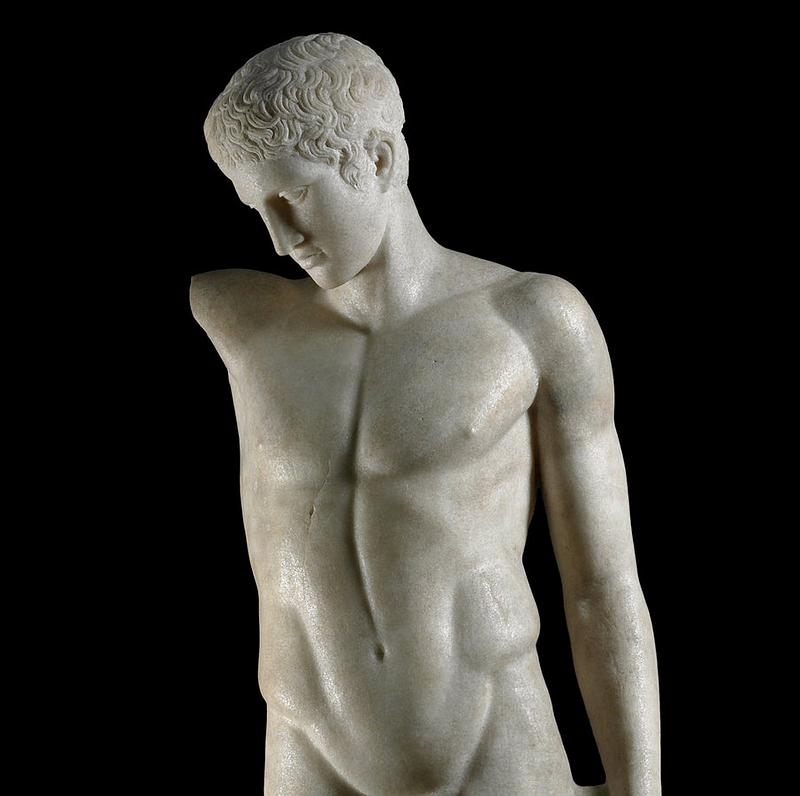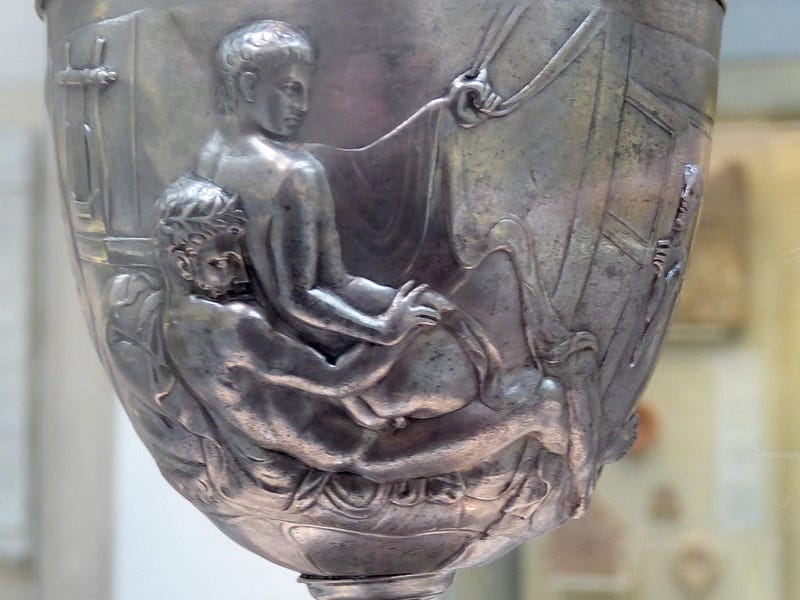Putting the ‘Bi’ in Bible
Yes, the Christian scriptures have bisexuality
When I grew up Evangelical it seemed like the Holy Scriptures were a sex-free zone. Or everyone was married, and not even little bit ‘bi’.
Then I went along to college, and learned a few things I never heard in church—like most everyone in the ancient world was considered bisexual. And the theme is heavily featured in the Bible.

If we know one thing about guys in ancient Rome, it’s that they swung both ways.
This is something Christians don’t usually know, and everyone else does.
“Roman society almost unanimously assumed that adult males would be capable of, if not interested in, sexual relations with both sexes,” as John Boswell noted back in his 1980 book Christianity, Social Tolerance, and Homosexuality.
Roman bisexuality is on view in many sources. Lucretius, in De Rerum Natura (4.1052–57) refers to a “normal” man’s love for “either a boy or a woman.” Cicero notes that to bribe male jurors with erotic favors, both women and young men were required.
But somehow Christians keep saying the Bible is a “bi-free” zone.
It would be the only epic of world literature in which this was true. From the epic of Gilgamesh to the writings of Plato, and on and on, bisexuality just seems to be the human norm.
Was the Christian insistence accurate, however? Many Bible stories can seem a little bit bi. Or what could David be saying in 2 Samuel 1:26?
“…my brother Jonathan; very pleasant hast thou been unto me. Thy love to me was wonderful, passing the love of women.”

I think Christians know this is a “bi” situation.
As I look over Christian history, there’s startling examples of David and Jonathan being read as basically ‘gay’. It’ just not said openly. Elisabeth Elliot herself, the Evangelical punishing prude, wrote in a letter to her mother in the mid-1960s:
“David and Jonathan clearly had a much deeper love than the usual man-to-man friendship. They met in secret, they kissed one another, and they frankly said it passed the love of women.”
I suspect that many Christians have read the story this way. The story is naturally read this way. It’s just quiet. The religion would get mad, and nobody likes that.
Christians might like to say: Leviticus 18:22!
At any discussion of same-sex situations, a tiny, fragmentary verse in Levitical law of the Old Testament is propped up to deal with anything ‘queer’, and kill it off. For Christians, somehow, Leviticus 18:22 is like a cosmic lawnmower that chops down any same-sex suggestion.
Scholars sprang a surprise. The English translation is clarity itself, of course, but a literal scholarly translation runs a little different.
“And-with a male not you-will-lie ‘lyings-of’ a woman.”
What does this mean, exactly? No one really knows. And so the religion got away with changing the verse into something quite different: “You shall not lie with a male as with a woman…”
The Bible was actually always very “bi.”
Many stories from the scriptures have ambiguously sexual suggestion. There’s women who like women. Isn’t that the suggestion of Genesis 34:1?
“Now Dinah the daughter of Leah, whom she had borne to Jacob, went out to see the women of the land.”
As scholars note, biblical figures like Joseph and Jael read as very sexually ambiguous. It’s a very divine situation, apparently. The story of Ruth and Naomi looks a little bit lesbian. It would be read so if it wasn’t in the Bible.
But same-sex partners are quite common in the Bible. At Philippians 4:2–3, Paul writes about two women leaders who’d “labored with me.”
When men and women are paired together, as with Priscilla and Aquila, they’re read as husband and wife. So Euodia and Syntyche seem to be female partners, living and working together.
The idea of the Bible’s God being a force of straight men was just absurd.
That was a reading by straight men trying to rule populations. Did they have a conflict of interest? Their readings put themselves in power.
Read for itself, the Bible has a regular focus on single women and eunuchs. Jesus liked eunuchs and in Matthew 19:12 tells everyone to be like them! Eunuchs of the period were often homoerotically-inclined.
Many eunuchs had genital functioning, but they were famous for various creative sex techniques, and flamboyant presentation. One ancient Jewish writer, Philo, dismissed these “hybrids of man and woman continually strutting about . . .”
Scholars find “bi” narratives, lurking under the religion’s mistranslations and mistakes.
Take the Roman centurion and his ‘boy’. In 2004, Theodore W. Jennings Jr. and Tat-Siong Benny Liew had suggested that the narrative found in three gospels looked like a same-sex relationship. In a 2018 paper, “Gender Minorities in and Under Roman Power,” Zeichmann returns to the case, noting such a situation would be common for the period.
The Centurion calls his slave a Greek word, παῖς, that can suggest a sexual relationship. In Luke 7:2, the boy was “dear” or “precious” to him. It may not be ultra-explicit, but the relationship seems unusually close. Jesus does what Jesus does: healing, helping, and not asking a lot of questions.
Near the end of the New Testament is a tiny letter by the apostle Paul with a story about a slave.
Efforts to identify the hazy plot tend to run the gamut. But a 2011 paper by Joseph A. Marchal suggests basic terms have been misread.
Marchal works off the slave’s name: ‘Onesimus.’ In the Bible, names tend to set out the core of a character. Christian commentary typically says that Onesimus means ‘useful.’ But the name ‘Onesimus,’ Marchal says, means ‘good for use,’ ‘well-used,’ or ‘easy to use.’
To a person in the world of the New Testament, he writes, this suggests “the erotically available (or sexually vulnerable) enslaved person…”

Christianity broke its own rules here in saying “use” did not mean sex.
In Romans 1:26–27, the religion is happy to declare that “use” means “intercourse.” By the same rules, Onesimus is depicted as a male sex slave. A common figure in the ancient world. We might imagine a young, ‘pretty’, castrated male, often used for sex and companionship.
Philemon, his master, has a meaningful name too. It suggests the Greek word phileo, or ‘love,’ and also philema, which means ‘kiss.’ Philemon seems to be a man made for love. He seems to be a very ‘loving’ person — who has a male sex slave.
Thus we see a conflict — both in Christian anti-slavery teachings, perhaps, and in traditional Jewish views on same-sexual eroticism. It might be either which Paul steps forward, acting as a theologian, to help resolve. The apostle tells them to just love each other.
The reality is that Jews of the 1st century seem to been as “bi” as people at any other time.
As scholars have detailed, the cues and clues from the biblical world suggest as much same-sexual stuff as one would expect for a situation as common as dirt.
In a 2011 paper, Alan Cadwallader noted that, in 257 BCE, a Jewish leader of an aristocratic Palestinian family is recorded to have sent to the king of Egypt a gift of four young male slaves, two of them circumcised, apparently for erotic use. Is this surprising?
Herod the Great, the Jewish official who looms over the New Testament narratives, “had some eunuchs of whom he was immoderately fond because of their beauty.” The fact is recorded by Josephus, the Jewish historian, and just mentioned in passing.


In a cave in Beth Gurvin, there’s some touching graffiti.
“Here Philinus the youth buggered Papias, Craterus’ stepson.” These were names used by Jews.
There’s male-male sex in the Talmud itself. A scene recorded around the early 4th century but taking place earlier has Jewish guys having sex.
Consider the Warren Cup, a silver cantharus (a kind of drinking cup) that depicts scenes of men having sex. Its origins are murky, but it was apparently owned by a wealthy first-century Jewish household. It wasn’t some fetish object. It was just life.
Christopher B. Zeichmann discusses these scenes another in a 2020 paper, “Same-Sex Intercourse Involving Jewish Men 100BCE–100CE,” and he notes too that Romans too had a lot of anti-”gay” talk.
That’s the funny thing. Most everyone likes to dismiss same-sex sex — even as they do it. 🔶


